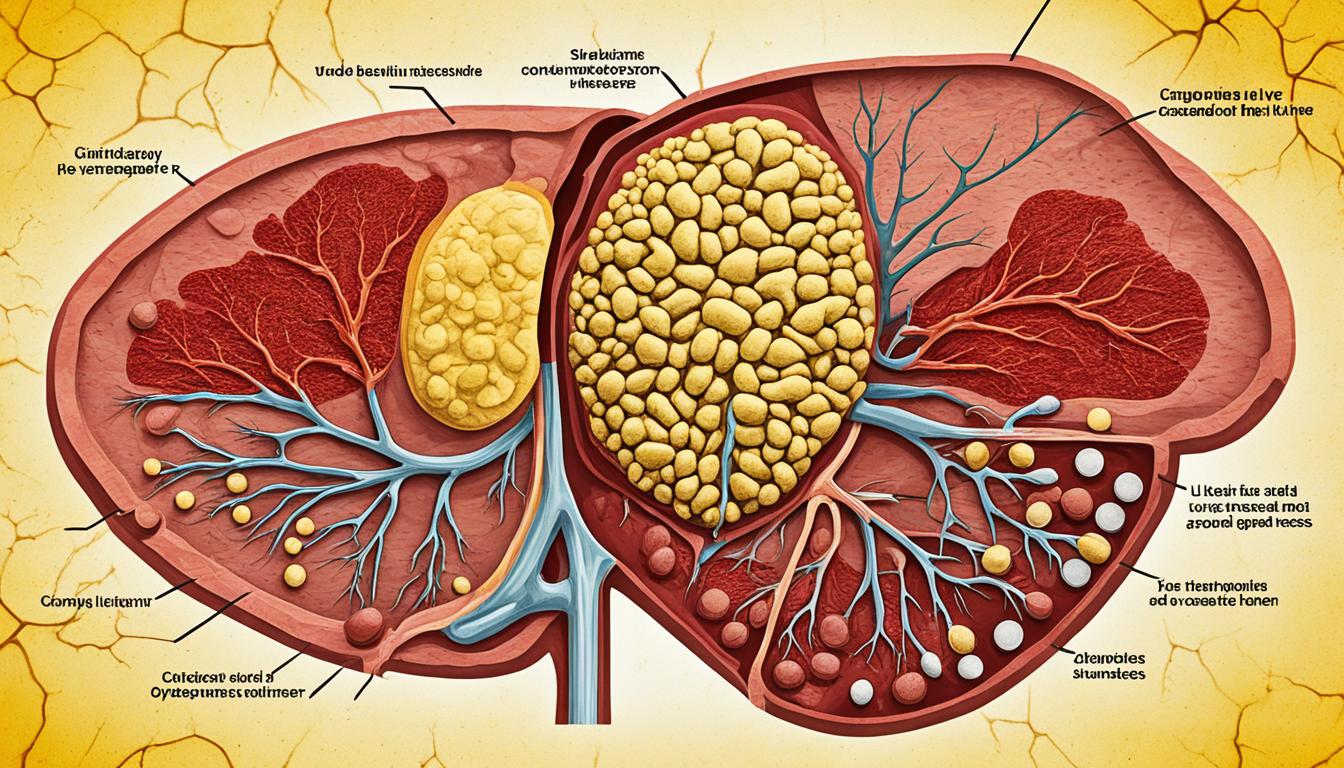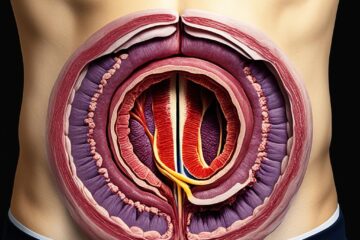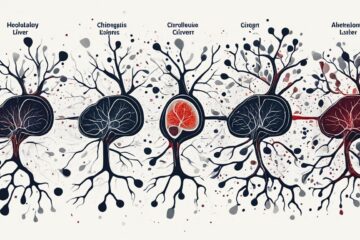Did you know cirrhosis of the liver causes about 1.3 million deaths each year?
Cirrhosis is a long-term liver disease. It happens when liver cells are replaced with scarring. This scarring lowers the liver’s ability to work as it should over time.
Learning about what causes cirrhosis and how to treat it is very important. Let’s look at what leads to it, its signs, how it’s found, and how to treat it. This way, we can better understand how to prevent or deal with cirrhosis.
Key Takeaways:
- Cirrhosis of the liver is a condition where scar tissue replaces healthy liver cells.
- It causes about 1.3 million deaths worldwide every year.
- Getting diagnosed early and right treatment are key for managing cirrhosis and helping the liver work better.
- Changing your lifestyle, like not drinking too much and staying at a healthy weight, can stop cirrhosis from getting worse.
- In severe cases, you might need medicine or surgery to treat cirrhosis.
Symptoms of Cirrhosis and Diagnosis
Cirrhosis of the liver is a severe condition with big health effects. Knowing its symptoms and getting an early diagnosis are key. This leads to timely treatment and better health outcomes.
Symptoms of Cirrhosis:
- Persistent fatigue
- Loss of appetite
- Nausea and vomiting
- Weight loss
- Abdominal pain and swelling
- Jaundice
- Itchy skin
- Easy bruising and bleeding
- Mental confusion and forgetfulness
If you have these signs, see a doctor. Early spotting helps in diagnosing this illness without delay.
Diagnosis of Cirrhosis:
Diagnosing cirrhosis involves taking a health history, examining the body, and tests. Physicians ask about your symptoms, health past, and risks. They look for signs like a big liver, yellow skin, or stomach swelling.
To confirm cirrhosis and see how bad it is, tests are needed. These might involve:
- Blood tests: They check liver function, find antibodies, and uncover the cause of liver harm.
- Imaging tests: Ultrasound, CT scans, or MRIs show liver images, finding any damage.
- Liver biopsy: A small part of the liver is tested to check for cirrhosis and its seriousness.
These tests tell healthcare experts what cirrhosis looks like for you. With a clear diagnosis, they can start the right treatments fast.
Understanding the Stages of Cirrhosis:
Cirrhosis moves through different stages as liver damage increases. Knowing these stages helps in choosing the best treatments and understanding the future. Here are the key stages:
| Stage | Description |
|---|---|
| Compensated Cirrhosis | The liver can still do basic jobs even with damage. Symptoms can be light or not there. |
| Decompensated Cirrhosis | The liver is badly off, so it struggles to work. Symptoms get worse and cause complications. |
| End-stage Cirrhosis | The liver is badly scarred and doesn’t function well. Severe issues like liver failure can be life-threatening. |
Cirrhosis’ stage guides treatment plans and monitoring of the disease’s progress.
Causes and Risk Factors of Cirrhosis
Cirrhosis of the liver is when liver tissue has scarring and damage. This happens over time. Many things can cause it, like the way you live and certain health issues.
Lifestyle Factors
Bad habits can put you at risk for cirrhosis. Drinking too much alcohol harms the liver. It causes cells to inflame and scar. Even if you don’t drink heavily, having several drinks can also hurt your liver.
Being overweight is another risk factor for cirrhosis. If you have too much fat in your liver, you may develop a type of disease. This disease can lead to cirrhosis.
Underlying Medical Conditions
Some health problems can lead to cirrhosis too. Viruses like hepatitis B and C are big culprits. They cause long-term inflammation, which can scar the liver.
Autoimmune diseases also play a role. Here, the immune system attacks the liver by mistake. This causes harm and can lead to cirrhosis.
Certain genetic diseases, like hemochromatosis and Wilson disease, can also directly damage the liver. The problem is having too much iron or copper. Some medications, toxins, and metabolic disorders can add to the risk.
Risk Factors
Certain people are at a higher risk of cirrhosis. They include those who:
- Drink too much alcohol
- Are overweight
- Have chronic viral infections (hepatitis B and C)
- Have autoimmune diseases
- Have genetic disorders (hemochromatosis, Wilson disease, etc.)
- Use certain medications for a long time
- Are exposed to toxins
- Have metabolic disorders
It’s crucial to lower these risks. Changing your lifestyle and getting regular check-ups are important. They help catch and treat any issues early, which might prevent cirrhosis.
Treatment Options for Cirrhosis
A full treatment plan is key when dealing with cirrhosis. It involves both medical and lifestyle changes. Everyone with cirrhosis should aim to make their liver healthier and their life better.
Medical Interventions:
Doctors treat cirrhosis by finding its root causes, tackling issues, and preventing more harm to the liver. They use different methods to do this. These may include:
- Patients are often given specific drugs to ease their symptoms or to deal with cirrhosis’s troubles. For instance, diuretics help lower fluid retention, and beta-blockers control blood pressure in the liver.
- When the liver is too damaged to work properly, a new liver from a donor can be the only solution. This is called a liver transplant.
Lifestyle Changes:
Aside from medicine, changing how you live can do a lot for cirrhosis. Here are some important changes to consider:
- Stopping alcohol is a must if you have cirrhosis from drinking too much. Support and counseling can help you quit drinking.
- Eating right is crucial. Go for foods low in salt and fat. Eat lots of fruits, veggies, whole grains, and lean proteins while avoiding processed foods.
- Keeping a healthy weight is also vital. Being overweight harms the liver. So, exercise and watch how much you eat.
- Having people who care around you and joining support groups can offer emotional strength and useful tips for dealing with cirrhosis.
“The treatment of cirrhosis requires a comprehensive approach that combines medical interventions with lifestyle modifications.”
It’s important to work closely with doctors, like hepatologists, and also dietitians. They will help create a treatment plan just for you. Regular check-ups are a must to see how you’re doing and to adjust your plan if needed.
| Treatment Option | Description |
|---|---|
| Medications | Prescribed medications aim to manage symptoms and complications associated with cirrhosis, such as fluid retention and high blood pressure in the liver. |
| Liver Transplant | In severe cases of cirrhosis, a liver transplant may be necessary to replace the diseased liver with a healthy liver from a donor. |
| Alcohol Abstinence | Avoiding alcohol is crucial for individuals with alcoholic cirrhosis to prevent further liver damage and promote liver healing. |
| Healthy Diet | A nutritious diet that is low in salt and fat can help minimize strain on the liver and support its optimal function. |
| Weight Management | Maintaining a healthy weight through regular exercise and portion control can reduce the risk of further liver damage. |
By mixing medical care with life changes, people with cirrhosis can better their health. Early treatment and lifestyle adjustments can improve health and lessen the impact of cirrhosis.

Prevention and Lifestyle Modifications
It’s key to prevent cirrhosis for a healthy liver and general well-being. By changing certain habits, people can lower their risk of this chronic disease.
1. Limit Alcohol Consumption
Drinking too much is a top cause of liver harm and cirrhosis. It’s vital to cut back on alcohol or stop drinking. Men should have up to two drinks daily. Women should stick to one. Remember, what’s too much alcohol can depend on your personal factors.
2. Maintain a Healthy Weight
Being obese or overweight ups the risk of liver problems, like cirrhosis. Eat well and stay active to keep a healthy weight and take pressure off your liver. A diet full of fruits, veggies, whole grains, and lean meats, along with exercise, helps keep your liver safe.
3. Practice Safe Sex and Needle Hygiene
Viruses like hepatitis B and C can lead to cirrhosis. Use protection during sex and always have clean needles if you use drugs. Also, it’s smart to get the hepatitis B vaccine for extra immunity against liver issues.
4. Avoid Exposure to Toxins
Contact with some toxins can lead to liver disease. Stay away from chemicals, pollution, and other harmful stuff. Wear protective gear, keep safety rules, and make sure you have proper air flow in places where toxins are present.
5. Seek Medical Care and Regular Screenings
Getting checked by a doctor often and having liver tests is crucial. This helps find any liver problems early. Have more check-ups if you’re at a higher risk of cirrhosis, like if you’ve had liver problems before.
Do these steps and make good life changes to avoid cirrhosis and keep your liver healthy.
Conclusion
Understanding cirrhosis’ causes and care is key. It helps in managing this long-term condition well. Knowing what risks and habits harm the liver, we can avoid cirrhosis.
Early diagnosis is crucial for better outcomes in liver cirrhosis. Regular check-ups and liver function tests can catch it early. This allows doctors to start treatments quickly.
A full approach is needed for treating cirrhosis. This includes medical help and lifestyle changes. These changes involve keeping a healthy weight, eating well, and staying away from too much alcohol. Also, it’s important to be active regularly.
It’s vital to spread awareness about liver cirrhosis. Focus on the importance of finding it early and getting the right help. This can help improve how we deal with it and make life better for those with cirrhosis.




